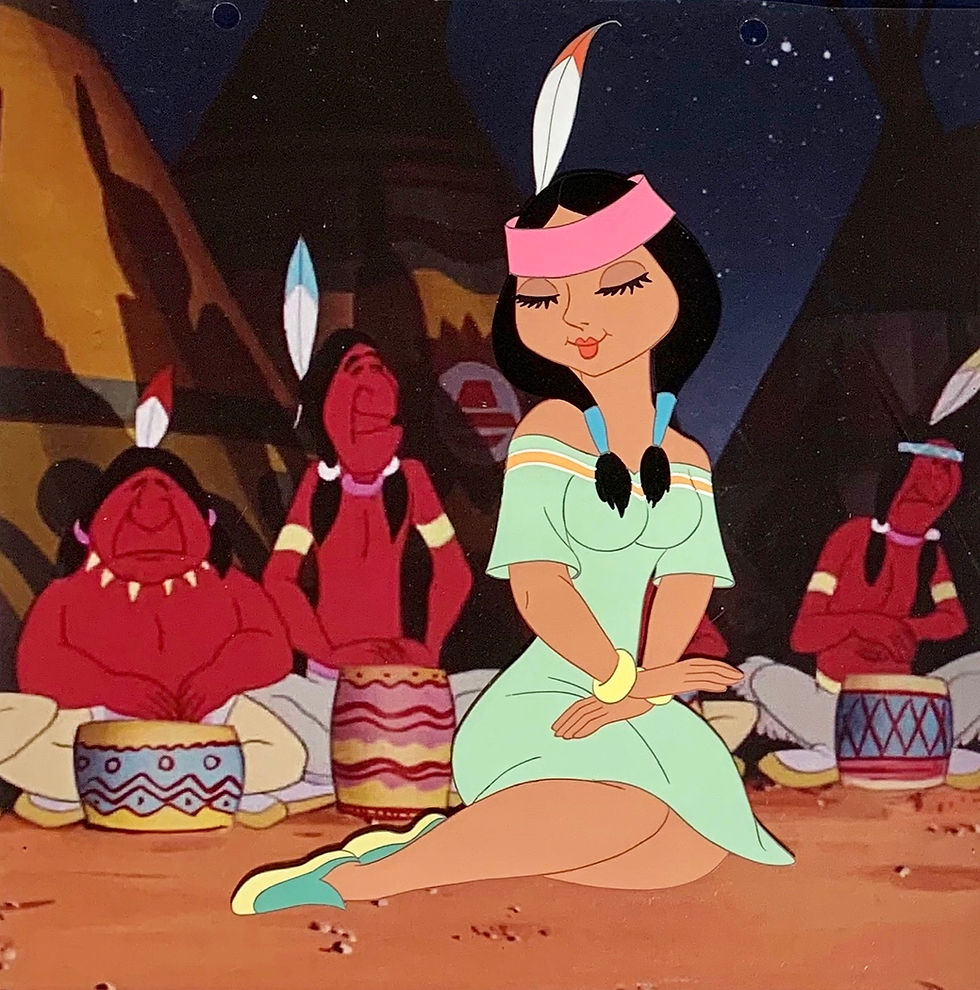Original Production Animation Cel of an Indian Girl from "Peter Pan," 1953
- Untitled Art Gallery
- Feb 6, 2019
- 3 min read
Updated: Mar 7, 2019

Original hand inked and hand painted production animation cel of an Indian Girl from "Peter Pan," 1953, Walt Disney Studios; Set over a lithographic background; Size - Indian Girl: 8 1/4 x 5", Image 9 x 9"; Unframed.
"When did he first say 'Ugh'? Hana mana ganda. In the Injun book, it say when first brave married squaw he gave out with head big 'ugh' when he saw his mother-in-law." - The Indian Chief
The author J. M. Barrie first used Peter Pan as a character in a section of the adult novel "The Little White Bird" in 1902. He returned to that character with his stage play entitled "Peter Pan, or The Boy Who Wouldn't Grow Up," which premiered in London on December 27, 1904. The play ran until 1913, and it was later adapted by Walt Disney for the animated feature film entitled, "Peter Pan," in 1953.
The Indian Chief is Tiger Lily's father and the leader of the Indians of Neverland. He was voiced by Candy Candido, who was an American radio performer, bass player, vocalist, and animation voice actor. He is best remembered for his famous line, "I'm feeling mighty low." Candido voiced many characters for Disney including: the Wolf's roars in "Peter and the Wolf," one of Maleficent's goons in "Sleeping Beauty," Shere Khan's roars in "The Jungle Book," the Captain of the Guard in "Robin Hood," Brutus and Nero in "The Rescuers," the deep voiced prisoner in the Haunted Mansion attraction, Fidget the peg-legged bat and a Reprobate in the Pub in "The Great Mouse Detective," and Bear growls (along with Clarence Nash) in "The Fox and the Hound." The Indian Chief was animated by veteran Walt Disney animator Ward Kimball.
From Walt Disney animator Andreas Deja (who animated Jafar):
"The Indian Chief was Kimball's main contribution to the film. What fantastic animation! So inventive (as usual). I remember thinking about this character frequently when animating dialogue scenes with Jafar. It's so much fun to come up with weird mouth shapes, as long as they work with the dialogue reading and the character's personality."
In the film when John Darling, Michael Darling, and the Lost Boys are out hunting Indians; they end up being captured by them instead. They are bound and taken to the Native Camp and brought before the Indian Chief. He believes that they have kidnapped his daughter Tiger Lily (who was actually kidnapped by Captain Hook and Mr. Smee), and he orders that they be burned at the stake if Tiger Lily doesn't return home by sunset. Fortunately, Peter Pan rescues Tiger Lily at Skull Rock and returns her safely home, just in time. The Indian Chief sets the boys free and makes them Honorary-Indians; he also names Peter Pan Chief Little Flying Eagle.
The Indian Chief and an Indian chorus sing the song "What Made the Red Man Red?", which explains the following: Why does he ask you, "How?", When did he first say, "Ugh!", and What made the red man red? (The song is very controversial due to the racist stereotypes of Native Americans). This is a very rare original production animation cel of an Indian Girl from the part in the song: "When did he first say 'Ugh'? Hana mana ganda. In the Injun book, it say when first brave married squaw he gave out with head big 'ugh' when he saw his mother-in-law." This is a very large image of this rare character from song "What Made the Red Man Red?" A beautiful piece of vintage Walt Disney animation artwork from the classic full length feature film "Peter Pan!"
#PeterPan #Disney #WaltDisney #animation #animationart #animationdrawing #EricLarson #MiltKahl #FrankThomas #RonClements #BobbyDriscoll #JMBarrie #animationcel #cel #productiondrawing #CaptainHook #untitledartgallery #PeterPan1953 #Tinkerbell #MarcDavis #OllieJohnston #WardKimball #JohnDarling #MichaelDarling #Wendy #WendyDarling #Indian #IndianChief #TigerLily #AndreasDeja #LostBoys #WhatMadetheRedManRed #CandyCandido #Neverland #MrSmee #Smee

